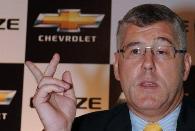 General Motors India plans to start a third shift at the Halol plant near Ahmedabad to cater to the additional production requirement after the launch of a light commercial vehicle in 2011.
General Motors India plans to start a third shift at the Halol plant near Ahmedabad to cater to the additional production requirement after the launch of a light commercial vehicle in 2011.
In a chat with Sohini Das, GM India president and managing director Karl Slym says, with the launch of the new compact car, Beat, and a positive response to the Cruze, GM plans to cross the 100,000-unit mark this year in sales.
The company has a slew of launches planned during the year, including the electric Spark, an upgrade of the Captiva and a CNG variant of the Chevrolet Aveo. Edited excerpts:
With the LCV in the offing, how do you plan to ramp up production at your Halol plant?
We plan to start a third shift at the Halol plant soon to cater to the production requirement.
The plant has a net installed capacity of 85,000 units in three shifts. We were operating in a single shift previously. We recently started a second shift at the plant.
I will call Halol a flexible plant that is capable of manufacturing all the models of GM India. Our Talegaon plant has a capacity of 145,000.
Of our last year's production, less than 40,000 units were produced at Talegaon and the rest at Halol. We sold around 70,000 units in the year. Talegaon currently produces only Spark.
How much direct employment could this generate and what is the likely investment?
At present, we have 1,350 people working at the Halol facility, that includes non-production staff as well. Roughly, 500 people could be added when a third shift will be started.
As for the investment, we plan to make some modifications at the plant. We will also invest in tooling and equipment. But, we are yet to arrive at exact figures.
Do you plan to source components for the LCV from China?
The LCV will be manufactured under the General Motors-Shanghai Automotive Industries Corporation (GM-SAIC) alliance.
We will launch three variants of the vehicle here and should start production by mid-2011 at Halol. We aim to have 90 per cent localisation for the LCV to begin with, and are in talks with local vendors for that.
What kind of volumes do you expect from the upcoming electric Spark?
We plan to launch the e-Spark by the end of this year and expect to sell around 5,000 units in 2011.
We are in talks with a couple of battery manufacturers in China and Japan and are trying to work on the battery price. We have already entered into an agreement with Bangalore-based Reva for sharing the technology to produce the electric Spark.
With the launch of the Beat, what kind of overall volumes do you expect this year?
We are bullish about growing by 50 per cent in terms of volumes this year, chiefly on the back of the new Beat and the great response that we have from the recently-launched Cruze. There is a two-month waiting period for the Cruze.
Having sold 70,000 vehicles last year, we hope to cross the 100,000 mark easily in 2010. However, sales are directly impacted by factors like interest rates and input costs.
The next six weeks are extremely important, as the run-up to the Union Budget. We have to wait and see whether the government decides to continue with or withdraw the stimulus offered to the industry.
What about export plans for the Beat?
No great export plans for the car as of now, but we plan to export 20 per cent of our production after 12 months of the production's start.
Last year, we exported less than 2 per cent of our net production to countries like Nepal, Bangladesh, Bhutan and Sri Lanka. This year, we plan to stick to around the same percentage.
Image: Karl Slym






